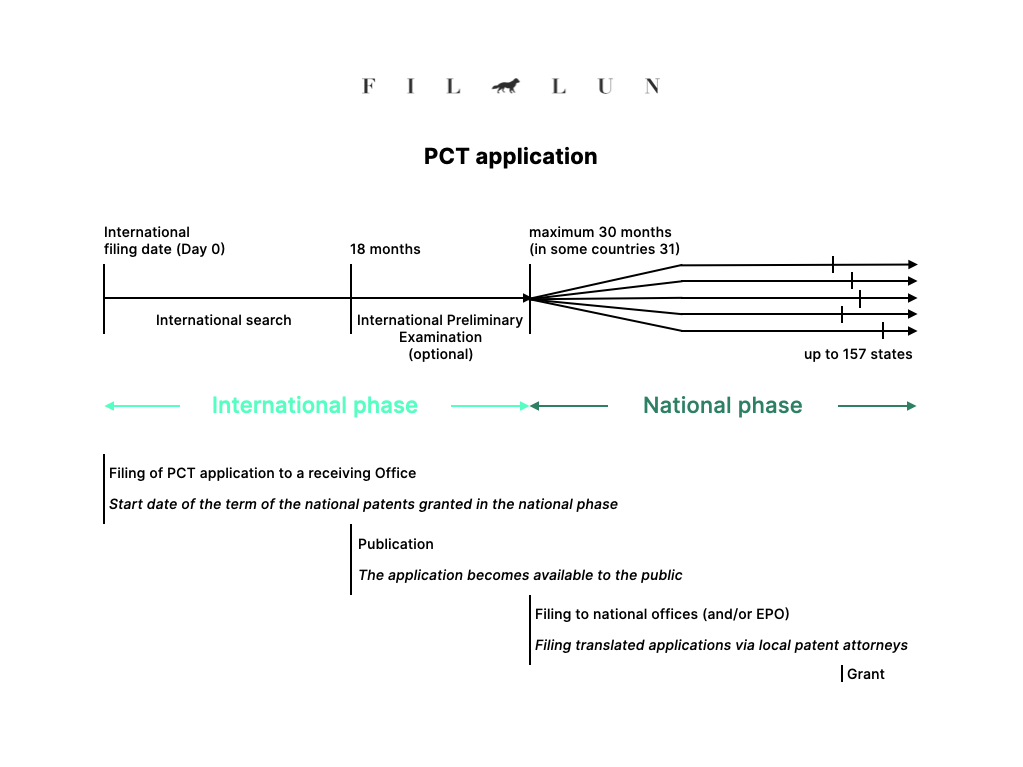PCT
(International patent application)
What is PCT?
PCT (Patent Cooperation Treaty) is one of the best things ever created in the world of Intellectual Property. It is also called international patent application (application, not patent!), since it has the broadest geographical scope. However, PCT will not result in a patent itself, so it will not end with an international or worldwide patent.
There is unfortunately no such thing as a worldwide patent. In the second part of the PCT procedure you will have to choose any PCT contracting states (states that are members of the PCT agreement) where you would like to obtain a patent. The second part of the PCT procedure is called national phase, where the procedure takes place before the designated patent offices. The PCT procedure will end with a certain number of national patents.
PCT is an international patent law treaty that provides a unified procedure for filing patent applications in up to 158 countries. (See the full list of countries here.) It is overseen by the World Intellectual Property Organization (WIPO).
Before PCT
Before PCT existed, applicants had to file patent applications in the priority year to every single country where they intended to obtain a patent. This resulted in paying a huge amount of fees at a very early stage, when applicants had no idea whether their invention will have any commercial success at all. Furthermore, in the first year it is difficult to predict the countries where it will be useful to have a patent later.
However, with the PCT – instead of having to file your application in X countries in X languages, using X patent firms and paying the fees of X patent offices – you can file a single application and then decide about the countries (any from the PCT contracting states) at a later stage.
PCT timeline
International phase: With a single filing you basically get a filing date that is valid for any PCT contracting states. In the international phase, patent protection is pending under a single patent application. The international phase does not end with a granted patent. The PCT application dies off at the end of the international phase, if the applicant does not enter national phase in at least one member state.
National phase: The final deadline for entering national phase is 2.5 years from the priority day. No matter where you start the national phase (you can choose any number of the PCT contracting states) the term of all of your national patent rights will start on the international filing date.
In the national phase, the PCT application is handled and examined at the local patent offices - according to the usual treatment of patent applications - in the countries chosen, and all of the local time limits, laws, rules, and procedures must be observed. Thus, the decision on granting patents is made exclusively by the national or regional Offices.
In the PCT procedure, some regional patent offices such as the European Patent Office (EPO) and Eurasian Patent Organization can also be designated in the national phase as if they were one country. (A European national phase is called Euro-PCT application.)
There are some countries where the deadline for entering national phase is 31 months instead of 30 months. For example, an Euro-PCT application can be filed within 31 months from the earliest priority date. The deadline for Canada and the United States is 30 months. (If you are interested in the deadlines when the national phase has to be started in certain countries, check WIPO's website.)
Advantages
Cost efficiency
Probably the most notable benefit of the PCT is cost efficiency. You can have a patent pending for up to 158 countries by filing a PCT application and paying only one set of fees. (Patent attorney fees will apply as well.) You can defer all the other costs, such as the translation and filing fees of the national patent offices that would otherwise occur at filing.
You will only have to pay these fees when starting national phase, within 2.5 years after filing. The fees payable at the start of the national phase depend on the number of countries you start the national phase in. However, they usually include translation fees, official fees, such as examination fee, and the service fees of the local patent attorneys.
Single filing in one language
Filing a single PCT application is much simpler than filing 10-20 patent applications within a short period of time. Furthermore, PCT streamlines the process of fulfilling diverse formality requirements. As are you probably aware, translation is a significant part of the costs. With PCT, you do not have to worry about translations for the first part of the procedure (30 months, which is 2.5 years).
It is important however to choose a filing language that is both accepted by the office who will be responsible for the search and that is a publication language. (Otherwise you will have to file translations.) English is a very good option.
So, with a single, online filing you can have a patent pending in all of the PCT member states.
Buy more time
One of the most important features of PCT is the first part of the PCT procedure, called "international phase". International phase adds up to 2.5 years to the procedure. Basically, with the filing of a PCT application, you are buying more time. You only need to elect the countries - and thus start national phase - within 30 months (2.5 years) after the priority date. So, PCT helps you delay both the decision and the respective fees and translation costs.
In order to decide where you need a patent, you need to know if there is a market for your invention and if so, in which countries. This is an almost impossible task at the time when you are filing your first application. Furthermore, your invention might already generate some income during the international phase that you can use when starting the national phase. So, international phase provides you with more time to focus on your product, do further research, check the market and evaluate your options.
Patentability
During the international phase, you will receive an international search report and a written opinion regarding your invention. These contain important information about the potential patentability of your invention, providing a strong basis for you to make business decisions about how to proceed.
On the other hand, if your invention appears to be not patentable according to the written opinion, you may abandon the PCT application. This way you will have saved the costs you would otherwise have incurred by directly filing applications in foreign countries, appointing local patent agents in each foreign country, preparing the necessary translations and paying the national fees.
If you are planning to abandon your application during international phase, you should consider withdrawing your PCT application before its publication so that it does not become available to third parties.
(Usually) shorter examination before the national patent offices
The search and examination work of the national patent offices in the national phase can be reduced since they have access to the international search report and the written opinion that were prepared by a prestigious international search authority (such as the EPO).
Disadvantage
One disadvantage is the relatively high official fees. Another disadvantage of the PCT route is that it adds 1.5 or 2.5 years to the patent procedure. Even though in most cases – see the reasons above – this is a benefit, it can be a disadvantage for some.
When to use PCT?
It is recommended to choose the PCT route if:
you need a patent in at least 2-3 member states of the PCT (almost all countries are members, but check the list of countries here), or
you need more time to decide about where you need patent protection, or
you need more time to get funding, or
you need more time to explore the commerciality of the invention and time to focus on building your business, or
in the first 2.5 years, you would rather spend money on your business instead of on patenting fees.
PCT with priority
If you are still paying attention, here is another important timeline. It is almost identical to the one above, but the time limits are calculated from the priority date. So, please remember that if you claim priority when filing a PCT application, the national phase has to be started within 30 months of the priority date. (Not the filing date.) However, the 20-year-long term of protection is still calculated from the filing date of the PCT.
Author: Zsofia Pintz
Published: August 2020
Updated: July 2023

Do you have any questions?
Feel free to contact us if you have any questions, suggestions or to arrange a consultation.
Related articles
Everything about priority
Priority is a very important definition for applicants. It safeguards inventors’ interests by providing them with highly valuable rights; most importantly with time. If you would like to claim priority, you only have 12 months to file any patent applications for the same invention.
European patent application timeline with expected costs
The European patent grant procedure lasts about two to five years from when the application is filed. In this rather long article you will find all the steps, deadlines and fees that occur during the process.
Costs of patenting
Estimating the exact costs is really difficult, since the costs vary considerably from country to country, and also depend on different factors, such as the nature and complexity of the invention, number of office actions and patent attorney’s service fees.






